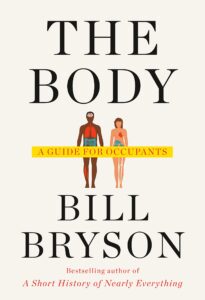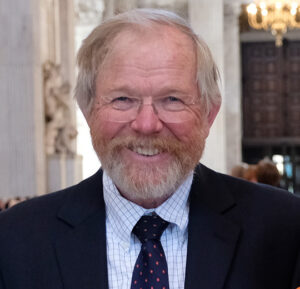Published in Canada by Anchor Canada, a division of Penguin Random House, 2021
Review by Laura Locke
Even though I never studied Science formally at university, I have realized rather late in life that I enjoy challenging my brain by learning about scientific principles, and discoveries throughout history in biology, chemistry and physics. This new interest of mine seems a bit odd to my family and friends, but there it is. I’m a big fan of the science documentaries presented by the Iraqi-British theoretical physicist Jim Al-Khalili (streaming on Prime Video), and I also love reading biographies of famous scientists. When I recently found out that bestselling author Bill Bryson had written a new book all about the intricacies of the human body, I couldn’t wait to get my hands on it.
Bill Bryson was born in Iowa in 1951, but settled in England in 1977, working in journalism before writing books. His first book, The Palace Under the Alps, And Over 200 Unusual, Unspoiled and Infrequently Visited Spots in 16 European Countries (Congdon & Weed Publishers, 1985) was not one of his most notable, but it led to a prodigious number of other books penned by Bryson, many of which have become bestsellers. Besides his very popular travel books, he has also written books about Shakespeare, his childhood, language, and history. He has, in fact, sold more non-fiction books in the U.K. than any other author, and in 2006 was awarded an OBE for his contribution to literature. Perhaps Bryson’s two most successful books have been The Mother Tongue: English and How It Got That Way (William Morrow Publishers, 1990), which explores the history and eccentricities of the English language, and A Short History of Nearly Everything (Doubleday, 2003), a widely acclaimed book on the history of science, both of which I thoroughly enjoyed. Bryson is known for his ability to make history and science understandable, as well as very entertaining.
 His latest book, The Body: A Guide for Occupants, could rightfully be called a ‘tour de force’ because of the sheer amount of intriguing, remarkable, and often bizarre facts about this form we occupy. Bryson draws on the knowledge of dozens of experts, and marvels as much as his readers at the details he discovers about our bodies. I learned more about the thousands of beneficial micro-organisms that live on and in my body than I probably wanted to know, but I also learned about countless other fascinating and rather mind-boggling realities about the human frame. For example, I now know that smell accounts for at least 70% of what we sense as the “flavour” of food … that our amazing hearts beat approximately 100,000 times a day … that every time we breathe, we exhale around 25 sextillion (that’s 2.5 x 1022) molecules of oxygen … and that we grow about 25 feet of hair in our lifetime.
His latest book, The Body: A Guide for Occupants, could rightfully be called a ‘tour de force’ because of the sheer amount of intriguing, remarkable, and often bizarre facts about this form we occupy. Bryson draws on the knowledge of dozens of experts, and marvels as much as his readers at the details he discovers about our bodies. I learned more about the thousands of beneficial micro-organisms that live on and in my body than I probably wanted to know, but I also learned about countless other fascinating and rather mind-boggling realities about the human frame. For example, I now know that smell accounts for at least 70% of what we sense as the “flavour” of food … that our amazing hearts beat approximately 100,000 times a day … that every time we breathe, we exhale around 25 sextillion (that’s 2.5 x 1022) molecules of oxygen … and that we grow about 25 feet of hair in our lifetime.
I also love that Bryson weaves in stories of many doctors, researchers and scientists throughout history who have tried to figure out the why’s and how’s of the workings of our body – sometimes correctly, and more often not. As well, he chronicles the development of many life-saving devices, procedures and medications (such as the X-Ray machine, heart transplants, and antibiotics.)
Bryson includes many particulars about our human body that continue to mystify the experts. Here’s an example, which also shows Bryson’s engaging writing style: In the early 1880s, German surgeon Gustav Simon “removed a diseased kidney from a female patient without having any idea what would happen, and was delighted to discover – as presumably was the patient – that it didn’t kill her. It was the first time that anyone realized that humans can survive with just one kidney. It remains something of a mystery even now as to why we have two kidneys. It is splendid to have a backup, of course, but we don’t get two hearts or livers or brains, so why we have a surplus kidney is a happy imponderable.”1
Bryson has been quoted as saying that he “is not a spiritual person”, and in this book he describes the human journey as a “long and interesting accident, but a pretty glorious one.”2 However, I found his latest book to be personally faith-boosting, and gave me a deeper understanding and appreciation of the wonder of life itself. Each and every one of us is a walking, talking miracle!
- The Body: A Guide for Occupants; pg. 154
- Ibid; pg. 10








